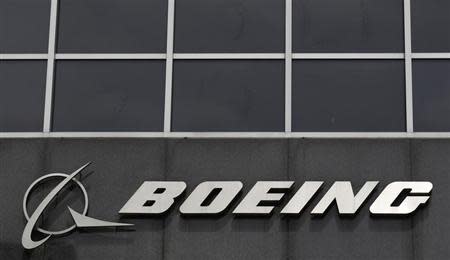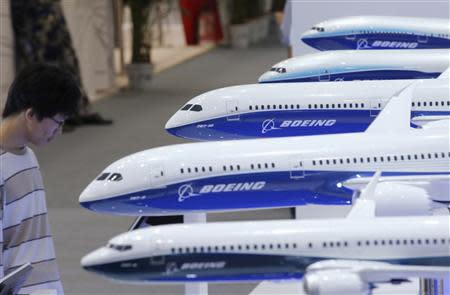Boeing raises forecast as quarterly profit jumps; defense weak
By Alwyn Scott (Reuters) - Boeing Co reported a surprising 12 percent jump in quarterly profit and raised its full-year forecast on soaring commercial aircraft production and margins, sending its shares up as much as 6 percent to an all-time high. The company also said on Wednesday that it will speed up production of its 787 Dreamliner, a long-awaited move that comes after a series of problems with the new, high-tech plane, and while Boeing is still pushing to improve the jet's reliability. The strong third-quarter results from the commercial airplane business, which churned out more planes at higher profit margins in the quarter, compensated for weakness in the defense unit, where revenue rose just 3 percent, margins contracted and profit fell. The commercial aircraft gains showed Boeing was not only on target to deliver a record number of jetliners this year, but was producing them efficiently. But the optimism was tempered by continuing 787 problems, by the loss of a key order in Japan earlier this month, and by the prospect that profit margins will fall in the current quarter. "Obviously that's a campaign that we did not want to lose," Boeing Chief Executive Jim McNerney said in a conference call, referring to rival Airbus' win of an order from longtime Boeing customer Japan Airlines Co Ltd . "We will take it as a sign to try harder and do better," he said, noting that Boeing recently won an order for 34 of its forthcoming 777-9X jet from Deutsche Lufthansa AG . Lufthansa contracted at the same time to buy 25 Airbus A350s. McNerney said the reliability of the 787 was averaging 97 percent, a decrease from 98.2 percent that Boeing cited in June, during a congressional hearing on the 787's burning battery problem, which prompted regulators to ground the plane for more three months earlier this year. "We still have some customers that are not at that level (of 97 percent)," McNerney said on Wednesday. "It's frustrating." False error messages account for about one-third of the reliability problems, he added. Boeing is putting people and spare parts around the world to help fix 787s quickly. The latest reliability concerns arose after Norwegian Air Shuttle took its new 787 out of service for repairs because of repeated problems. MARGIN AT RISK Boeing's commercial aircraft operating margin jumped to 11.6 percent in the latest quarter from 9.5 percent a year ago. But the gain begged the question of "whether this is a 'one off', or whether such levels can be sustained," analyst Robert Stallard at RBC Capital Markets wrote in a note. On the conference call, Chief Financial Officer Greg Smith said the commercial airplane operating margin may soften in the current quarter. "We expect fourth-quarter margins to be influenced by dilution from the (low margin) 787 deliveries, higher (research and development) primarily associated with the 737 MAX and timing of supplier payments," Smith said. Investments to lift production rates also will weigh on margins, he said. The 787 margin rose from near zero to "very low single digits" in the third quarter as Boeing expanded the number of airplanes use to calculate costs by 200, to 1,300, and included the cost of 787-10 development. After the conference call, Boeing stock declined from its early highs. The stock was up 5 percent at $128.63 in afternoon trading on the New York Stock Exchange after rising as much as 6.2 percent to $129.99. "Clearly the 787 will be more detrimental for margins," said Ken Herbert, analyst at Canaccord Genuity Inc. In contrast with the booming jetliner business, Boeing's defense operations were weakened by declining U.S. government spending, a charge to close the C-17 transport plane production line and other factors. Military aircraft revenue fell 5 percent to $3.5 billion. Overall defense, space and security revenue rose to $8 billion from $7.8 billion, but operating margins contracted to 7.4 percent from 10.5 percent. Earnings in that division fell 19 percent to $673 million. GUIDANCE RISES Third quarter net income rose 12 percent to $1.51 a share from $1.35 a year ago as revenue increased 11 percent to $22.13 billion, Boeing said. The gain came largely from a 14 percent surge in deliveries to 170 aircraft in the quarter. Core earnings, which exclude some pension and post-retirement costs, jumped 16 percent to $1.80 a share from $1.55. The core earnings and revenue results topped analysts' average expectations of $1.55 a share and revenue of $21.68 billion, according to Thomson Reuters I/B/E/S. Boeing raised its full-year core earnings forecast to between $6.50 and $6.65 a share from a previous outlook of $6.20 to $6.40. "Simple takeaway is stay long," on the stock, Peter Arment, an analyst at brokerage Sterne Agee, wrote in a note. "We remain buyers at current levels given our long-term targets" of $164 on Boeing stock. In a long-anticipated move, Boeing said it would increase production of the 787 Dreamliner to 12 aircraft per month in 2016, up from a target to 10 per month by the end of 2013. It plans to produce 14 per month before the end of the decade. The plane has suffered a number of technical glitches during its first two years in service, including overheating batteries that grounded the worldwide fleet for more than three months earlier this year. Rising production increases revenue and cash flow. But "given that it doesn't kick in till 2016, the benefits of this remains some way off," RBC Capital's Stallard wrote. Boeing left unchanged its full-year revenue forecast at between $83 billion and $86 billion, and its target for delivering between 635 and 645 jetliners this year. In the first nine months, Boeing delivered 476 planes, including 170 in the latest quarter. That means it needs to deliver 169 in the fourth quarter to hit its top target. McNerney said Boeing expected to start work on its 777-X models later this year, cementing those long-awaited revamps of its best-selling wide-body plane, due to enter service by 2020. Industry experts widely expect that launch to coincide with major orders at the Dubai Airshow next month. (Reporting by Alwyn Scott in New York; Editing by Gerald E. McCormick, Jeffrey Benkoe and Tim Dobbyn)



